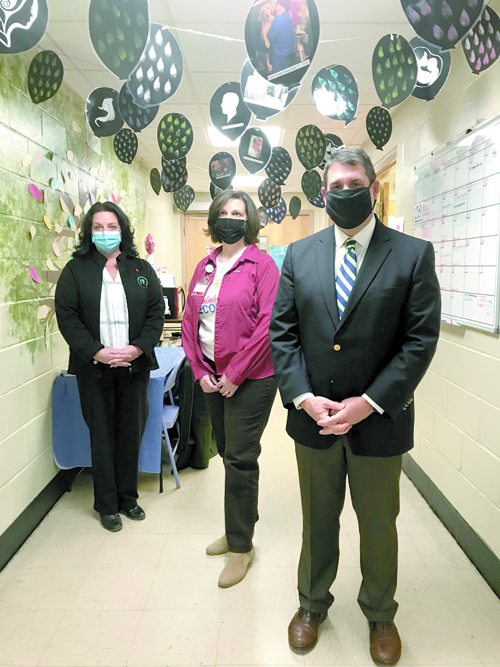Somber Stat: Two people a day dying from overdoses

By Dawn De Busk
Staff Writer
A young girl was left behind after her parent died from an overdose from an opiate-based drug.
She lives with guilt because there was an overdose reversal medicine in the house, but the girl did not know how to use it.
“I had a person who lost her only parent to an overdose. And she asked me, a complete stranger, to go to the funeral home with her. She said to me, ‘I had that stuff in the house and I didn’t know how to use it,’ ” according to Candy Greenberg, communications specialist at Lakes Region Recovery Center.
The young girl’s story demonstrates how vital it is for the general population to know how to use Narcan, Greenberg said.
It also stands as a testament to how out of control the opioid crisis has become.
Last year, 636 people in Maine died from overdoses from opiates and/or fentanyl.
This month, a black balloon banner was designed to represent each of those lives lost in 2021. The banner hangs from the ceiling of a hallway at the recovery center.
“Right now, the rate: Two people a day in the State of Maine are dying,” according to LRRC Executive Director Tracy Martin.
Greenberg said the deaths aren’t just happening somewhere else. People in our communities are dying, she said.
There has been a steady increase inoverdose deaths each year. It was 417 in 2019; 504 in 2020; and 636 in 2021.
“It is staggering. These are people that we know. We know these people. We’ve met these people. It has been a tough year, most definitely,” Greenberg said.
“Six-hundred thirty-six lives lost to opioid overdoses in the state of Maine, in one year,” she said.
“We invited family members who lost a loved one to send us in pictures and information. As you walk by the banners, you’ll see the faces of the people who died. We added on top of that the exact number of tear drops to represent each of the 636 people,” she said.
National Black Balloon Day was March 6.
“But, we cannot release balloons because to release balloons into the environment, hurts the birds and other animals, and is against the law,” Greenberg said.
The Maine legislature passed a law in July 2021 that prohibits the intentional release of balloons. Balloons are considered litter, and fines are associated with purposefully letting them go outdoors.
“This is our version of a balloon release,” she said, pointing to the garland of black teardrops hanging from the ceiling.
“This we can keep forever. We are going to keep it here throughout the month of March. Then, after that Crooked River Counseling has requested it fly in their office, where they will have it for a week. Someone on Facebook asked if it could be brought to the Causeway,” she said. “We are going to make it our traveling banner.”
On Friday afternoon, a representative from U.S. Sen. Susan Collins’ office stopped in to see the Black Balloon Banner and the non-profit recovery center located behind the hospital.
“Sen. Collins is very involved and concerned about the opioid epidemic. She is working very hard to find some sort of treatments. She’s on the HELP Committee— the Health, Education, Labor and Education Committee,” Winter said.
“She knows how much it [the opioid epidemic] has impacted Maine,” he said.
Martin and Greenberg took an opportunity to talk about the importance of getting Narcan, the overdose-reversal medicine, into the hands of more people and getting those people trained to administer Narcan.
It’s like having a fire extinguisher, they said.
Doses of Narcan are free at the center. Also, classes on using Narcan are held once a month.
Lakes Region Recovery Center, 25 Hospital Drive in Bridgton, is a drop-in center that is open Monday through Friday, 9 a.m. to 5 p.m. People do not need an appointment to stop in. The website address is lrrcbridgton.org. To get recovery support over the phone, call 803-8709.

